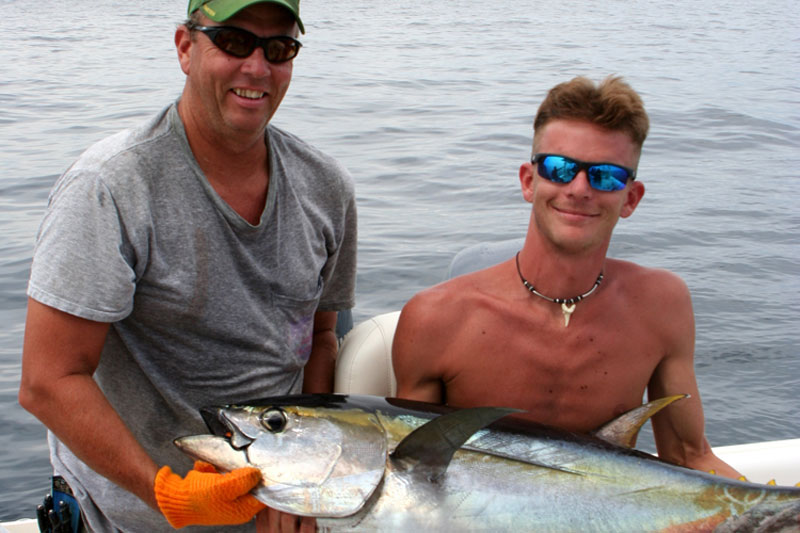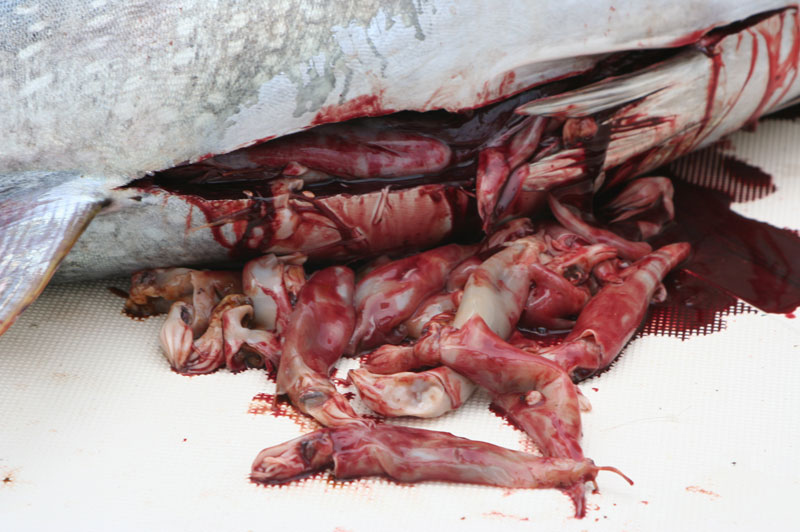Trolling is often the way to get yellowfin tuna on the line and last month we touched on the how-to info in Yellowfin Tuna Fishing Tactics Part One: Trolling, but at times it's the chunking bite that's off the hook. Just about every boat in the charter fleet chunked every day back in the 90s, unless the clients specifically wanted to catch billfish. It may have been a cycle or just one of those flukes of nature that caused mass schools of yellowfin to invade the Mid-Atlantic. Before we dig into the details, check out this video of Angler in Chief Lenny Rudow, giving a how-to tuna chunking seminar at Alltackle in Annapolis.
Tuna Chunking Baits and Tackle
Butterfish are the number one chunk bait and are readily available in frozen boxes called flats. Usually three flats suffice for a full day of serious chunking. Open and check the flats while you’re still at the bait shop to make sure they have not thawed and been re-frozen. (Which I can assure you does occur, more than once I’ve opened an inferior flat of bait 40 miles off the beach). Good butterfish will have clear eyes and won’t be yellowed with freezer-burn and rot.
Circle hooks out-fish J-hooks in this fishery, period. The beauty of the circle hook is that tuna can hook themselves with the rod in the holder when no one is paying attention. Butterfish are rigged by going in the mouth with the hook and out a gill, then going under the fish and inserting hook back inside the other gill. Finish it off by embedding the hook in the stomach with just the tip exposed. Done properly, the hook is concealed within the fish with the leader coming out of the mouth.

A spinning butterfish does not catch tuna. In a strong current it’s often better to drift than anchor. This keeps the bait from spinning as much, since it drifts along with the current, assuming the wind and current are running the same direction. If the wind and a strong current are running in opposite directions, well, as they say in the military, chunking can be FUBAR.
Fluorocarbon leaders are a must, not an option. The poundage can change depending on conditions. Bright sunny days with crystal clear water often causes yellowfin to become leader-shy. Begin with 50-pound test leader, dropping down to 40, and then 30 if necessary. Fishing at the Lumpy Bottom one afternoon I actually found it necessary to use 18-pound fluorocarbon to get the finicky yellowfin to pick up the bait. You could observe them cutting behind transom picking off chunks being thrown over the side, but they wouldn’t touch a line until dropping down to 18-pound flouro. The charter didn’t get to land many of the 50-pound-class beasts, but they had a blast trying.
A standard chunking leader is made with a six-foot piece of fluorocarbon, the circle hook, and a small black barrel swivel tied to the main line. There is no need for wiring the tuna; the fish is wound within gaffing distance. Rods and reels are a matter of your personal preference and the prevailing size of the fish, with most anglers opting for 30- to 50-pound-class tackle with lever-drag reels.
Chunking Up the Tuna
Butterfish are cut into five or six pieces and used to chunk. Throwing a piece of chunk spaced about every six feet or so, with an occasional handful thrown in for good measure, attracts fish. Menhaden oil helps keeps tuna in the vicinity as well. Increased tuna activity can also be obtained by using a frozen bucket of menhaden, like when sharking. Cut a couple holes in the bucket and suspend it over the side. This provides four or five hours of chum flow which attracts all types of baitfish along with tuna. Note: these are only enhancements to the chunks of butterfish, which must be thrown over.
It’s a good idea to precut half a flat and put it off to the side in preparation for when the bite turns on. No one wants to cut up chunks when the rods go down, but the number one mistake made after a hook-up is that chunks are not thrown continually. Everyone has a job and someone must be assigned to continue throwing chunks, to keep the school of fish behind the boat. A school of yellow or bluefin will stay close by as long as the food source is present, but if you stop chunking, the crew will get to watch a boat nearby catch “your” school of fish.

Set up by suspending baits at various depths corresponding with the flow of the chunk line. The chunk’s rate of descent varies day to day depending on the current, so lines are not always set at the same depths or distance from boat. Lines consist of floaters (no weight) to lines set all the way to the bottom. Egg sinkers are used for weight. Slide the sinker at least 20 feet up the line from the hook, and hold it in place with a rubber band. Anywhere from one to six ounces of lead is normally sufficient, however, occasionally there will be a strong current below the thermocline making a pound or more of lead necessary for deep lines. Bait positioned five feet off the bottom can often be the ticket (especially when bluefin are around) if schools of sand eels are observed near bottom on your sonar.
Tuna are opportunist, feeding on what is available. In past years scallop boats invaded the 30-fathom lumps off Delmarva Peninsula when the northern scallop zone was shut down. This resulted in a fleet of boats working in close proximity, and scallop guts (obtainable from trawlers in exchange for a dozen donuts or some beverages) became the choice bait. This created a different type of chunking. Clams were carried onboard for bait just in case scallop guts were not available. However, unless a fleet of scallop boats work an area, it does not seem to be worth the effort using clams.

Finally, when chunking, cooperate with other boats. When setting anchoring give ample space for fighting fish and take into account the long anchor lines that may be required to hold bottom in deep water. And if the fleet is drifting, drift! I know that anglers have the right to fish where ever, whenever, and however they desire. I respect that right. However, if you drop anchor in the middle of 100 drifting boats, don’t be surprised when you hear on the radio that your mom was not married at the time of your birth!
- By John Unkart. For additional information on catching tuna, check out John Unkart’s books on Amazon, Offshore Pursuit and Saltwater Tales.
Tuna Chunking Tips
- Finicky tuna may be coaxed into biting by hand-feeding the bait. The technique is accomplished by rigging a line with no weight or float. A piece of butterfish is used instead of a whole fish as bait. Throw a handful of chunks into the water along with the bait. Turn the clicker on and set the drag so line can be stripped off the reel by hand, keeping enough drag tension to prevent a backlash when a strike occurs. Strip line from the reel and allow the baited piece to drift naturally along with the handful of chunks. Once it has drifted out 100 yards, wind it back in and repeat. Many times tuna refuse to eat a stationary piece of butterfish, insisting on a bait that’s drifting as naturally as possible with the current.
- Have two lines rigged and ready to go upon arrival. The change in engine noise as rpms drop sometimes attracts yellowfin and often a tuna can be in thrown in the box as the anchor is being set. As soon as the boat slows down, throw a floater line over and another line with butterfish suspended 15’ under a float. Free-spool both lines while setting the anchor.
- There is often a bite right before the sun rises, which means pulling out of the slip at three a.m. is often beneficial.
- Rig a line with a whole butterfish 30 feet from a float, with no weight. Drift it back 200 yards from the boat, before winding in and repeating.
- Always set a line just above the thermocline with a whole butterfish.
- Check the stomach of a fish you caught to see what the tuna are feeding on. A stomach full of squid suggests you might try rigging a whole squid and hand-feeding it on a line. (Go on YouTube, search “Earth Sports: Rigging Squid,” and watch my video on how to rig squid).
- Hang a big diamond jig off an outrigger suspended around 30 feet. The rocking of the boat provides great lure action; just be sure not to set the outrigger clip too tight.
- Live baits including spot or mullet also do well swimming in the chunk line. In addition, they not only catch tuna but everything else as well. Our clients have taken several marlin on live spot while chunking.
- My number-one way to turn on a bite for a charter: use a cast net the night before, and fill a five-gallon bucket with peanut bunker. Use them in the chunk line to fire up the yellowfin – it’s not uncommon to have them boiling and busting water behind the boat, when peanut bunker are floating around.